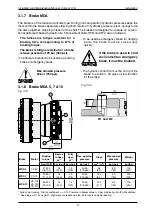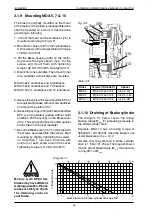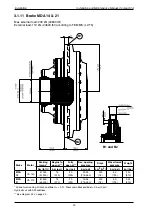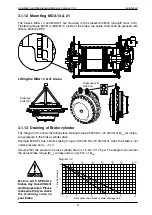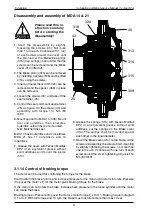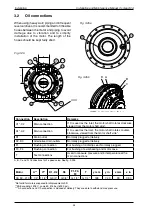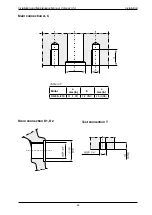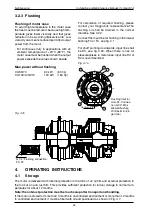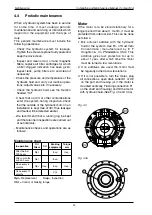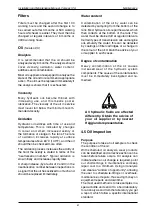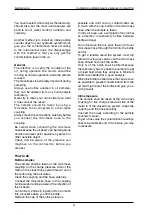
41
Installation and Maintenance Manual, Compact CA
All hydraulic fluids are affected
differently. Obtain the advice of
your oil supplier or by nearest
Hägglunds representative.
Filters must be changed after the first 100
working hours and the second change is to
be carried out after 3 months or 500 working
hours whichever is earlier. They must then be
changed at regular intervals of 6 months or
4000 working hours.
Oil
(Se also .3)
Analysis
It is recommended that the oil should be
analysed every 6 months. The analysis should
cover viscosity, oxidation, water content,
additives and contamination.
Most oil suppliers are equipped to analyse the
state of the oil and to recommend appropriate
action. The oil must be replaced immediately if
the analysis shows that it is exhausted.
Viscosity
Many hydraulic oils become thinner with
increasing use, and this means poorer
lubrication. The viscosity of the oil in service
must never fall below the minimum recom-
mended viscosity.
Oxidation
Hydraulic oil oxidizes with time of use and
temperature. This is indicated by changes
in colour and smell, increased acidity or
the formation of sludge in the tank. The rate
of oxidation increases rapidly at surface
temperatures above 60°C (140°F), and the oil
should then be checked more often.
The oxidation process increases the acidity of
the fluid; the acidity is stated in terms of the
"neutralisation number". Typical oxidation is
slow initially and increases rapidly later.
A sharp increase (by a factor of and 3) in the
neutralisation number between inspections is
a signal that the oil has oxidized too much and
should be replaced immediately.
Filters
Contamination of the oil by water can be
detected by sampling from the bottom of the
tank. Most hydraulic oils repel the water, which
then collects at the bottom of the tank. This
water must be drained off at regular intervals.
Certain types of transmission oils and engine
oils emulsify the water; this can be detected
by coatings on filter cartridges or a change in
the colour of the oil. Obtain the advice of your
oil supplier in such cases.
Degree of contamination
Heavy contamination of the oil causes
increased wear of the hydraulic system
components. The cause of the contamination
must be immediately investigated and re-
medied.
Water content
Maintenance
4.5 Oil inspection
Purpose
The purpose to take an oil sample is to check
the condition of the oil.
With scheduled oil analysis, wear products
can be identified and corrective action can be
taken before failure occurs. Oil analysis can
indicate when an oil change is required, point
out shortcomings in maintenance and keep
repair cost to a minimum. Using oil analysis
can create a “window of opportunity”, allowing
the user to schedule re-fittings or overhauls,
maintenance or repairs, thus saving money on
equipment repairs and downtime.
The most used method is to take samples in a
special bottle and send it to a fluid laboratory
for an analysis and from the laboratory you get
a report, which follow a specific international
standard.

